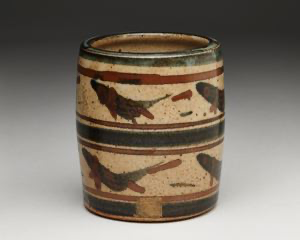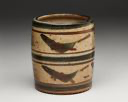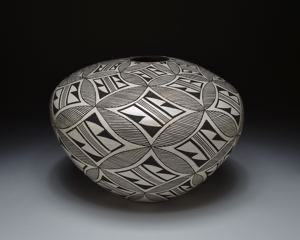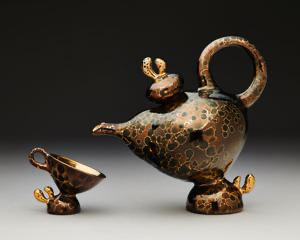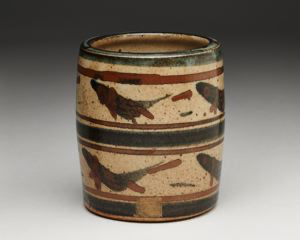| Showing 1 of 1 |
|
Bernard Leach
British
(1887–1979)
Jar
circa 1960
Stoneware
4.375 x 3.75 x 3.75 in.
Gift of Richard A. Harrison
1984.6
Having spent most of his life in England and Japan, Bernard Leach is an exception in this catalogue, which focuses on ceramics created in the United States, but his influence has been so widespread and profound in the US that it was impossible not to include him.
Jar exemplifies Leach’s blend of Japanese and British traditions. Its simple form is embellished with a controlled line pattern framing loose, abstracted fish imagery. This approach was meant to stand apart from industrially made ceramics; a user would know it is handmade yet intended to be used for everyday purposes. Stoneware clay is the most durable, being fired at a higher temperature, and is thus ideal for utilitarian pottery.
Leach was born in Hong Kong but lived in Kyoto, Japan, for four years after his mother died in childbirth. He moved back to Hong Kong, and then to Singapore, before his family returned to England. After studying at the Slade School of Fine Art in London, then a brief stint as a bank clerk, he learned etching at the London School of Art, and decided to return to Japan with the intent of teaching etching. Shortly after arriving he was introduced to raku firing at a party, and immediately decided to apprentice in Japan as a potter.
Leach’s A Potter’s Book, first published in 1940, was for many years considered the potter’s bible, providing guidance on Korean, Japanese, Chinese, and English traditions of pottery, with recipes for glazes, and information about forms, clay bodies, and more. However, it was during Leach’s extensive travels that he made the most significant impact. During the 1950s, he traveled throughout the United States with two close friends, Japanese master potter Shōji Hamada and philosopher Soetsu Yanagi. Together they conducted throwing and firing demonstrations, shared the teachings of Zen Buddhism and the aesthetic propositions of mingei (the folk craft movement in Japan), and provided a window into cultural traditions that potters had previously never encountered. Katie Lee-Koven
Click a term to view the records with the same keyword
- abstraction
- fish
- jars - Deep, wide-mouthed vessels used for holding a variety of substances, usually without handles and generally cylindrical, although sometimes made in other shapes. For narrower-necked vessles, use "bottles."
- symmetrical
- utilitarian objects - Object genre including items, equipment, accessories, and other things that are utilitarian in purpose rather than purely decorative. Objects having a primary purpose of being useful and used, rather than purely decorative.
- Ceramic Case 7: Southern California Connections , 8/17/2012 - 11/4/2013
- Black Mountain College: Shaping Craft + Design , 8/25/2014 - 2/28/2015
- Unearthed , 8/23/2022 - 5/14/2023
This object is a member of the following portfolios:
Your current search criteria is: Objects is "Jar".

